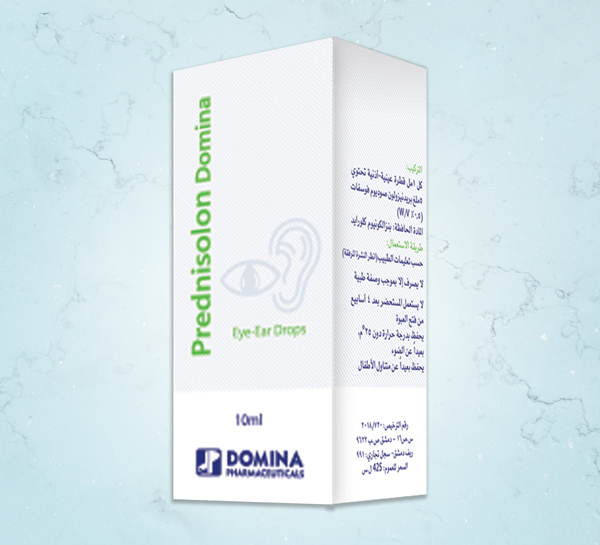
COMPOSITION:
Each 1ml Eye-Ear drop contains:
5mg Prednisolone Sodium Phosphate (0.5% w/v)
Preservative: Benzalkonium Chloride.
INDICATIONS:
1- Short term treatment of steroid responsive inflammatory conditions of the eye after clinical exclusion of bacterial, viral and fungal infections.
2- Non infected inflammatory conditions of the ear.
DOSAGE AND ADMINISTRATION:
Eyes: 1 or 2 drops instilled into the eyes every one or two hours until control is achieved, when the frequency may be reduced.
Ears: 2 or 3 drops instilled into the ear every two or three hours until control is achieved, when the frequency can be reduced.
Frequency of dosing depends on clinical response. If there is no clinical response within 7 days treatment, the drops should be discontinued. Treatment should be the lowest effective dose for the shortest possible time. After more prolonged treatment (over 6-8 weeks), the drops should be withdrawn slowly to avoid relapse.
CONTRAINDICATIONS:
- Bacterial, viral, fungal tuberculous or purulent conditions of the eye.
- If glaucoma is present or where herpetic keratitis (e.g. dendritic ulcer) is considered a possibility. Inadvertent use of topical steroids in the latter condition can lead to the extension of the ulcer and marked visual deterioration.
- Hypersensitivity to the preparation.
- In the ear, topical corticosteroids are contraindicated in patients with fungal diseases of the auricular structure, and in those with a perforated tympanic membrane.
SIDE EFFECTS:
- Hypersensitivity reactions usually of the delayed type may occur leading to irritation, burning, stinging, itching and dermatitis.
- Topical corticosteroid use may result in increased intraocular pressure leading to optic nerve damage, reduced visual acuity and visual field defects.
- Other side effects include mydriasis, ptosis, epithelia punctate keratitis and possible corneal or sclera malacia.
- Intensive or prolonged use of topical corticosteroids may lead to formation of posterior subcapsular cataracts.
In those diseases causing thinning of the cornea or sclera, corticosteroid therapy may result in thinning of the globe leading to perforation.
Vision, blurred
PRECAUTIONS:
-Topical corticosteroids should never be given for an undiagnosed red eye as inappropriate use is potentially blinding.
-Prolonged use may lead to the risk of adrenal suppression in infants. Potential systemic effects may include growth retardation in children and adolescents and more rarely a range of psychological or behavioural effects including depression or aggression (particularly in children).
- Ophthalmological treatment with corticosteroid preparations should not be repeated or prolonged without regular review to exclude raised intraocular pressure, cataract formation or unsuspected infections.
-The use of corticosteroids may reduce resistance to or mask the signs of infection. Appropriate anti-infective agents should be used if infection is present.
-Systemic effects of nasal corticosteroids may occur, particularly at high doses prescribed for prolonged periods. These effects are much less likely to occur than with oral corticosteroids and may vary in individual patients and between different corticosteroid preparations.
Potential systemic effects may include Cushing’s syndrome, Cushingoid features, adrenal suppression, cataract, glaucoma and more rarely, a range of psychological or behavioural effects including psychomotor hyperactivity, sleep disorders and anxiety.
Visual disturbance may be reported with systemic and topical corticosteroid use.
If a patient presents with symptoms such as blurred vision or other visual disturbances, the patient should be considered for referral to an ophthalmologist for evaluation of possible causes which may include cataract, glaucoma or rare diseases such as central serous chorioretinopathy (CSCR) which have been reported after use of systemic and topical corticosteroids.
Drug Interactions:
1- Prednisolone Sodium Phosphate Drops contain benzalkonium chloride as a preservative and, therefore, should not be given to treat patients who wear soft contact lenses.
2- Co-treatment with CYP3A inhibitors, including cobicistat-containing products, is expected to increase the risk of systemic side-effects. The combination should be avoided unless the benefit outweighs the increased risk of systemic corticosteroid side-effects.
Effects on ability to drive and use machines:
Prednisolone Sodium Phosphate Drops has moderate influence on the ability to drive and use machines.
It may cause transient blurring of vision on instillation, warn patients not to drive or operate hazardous machinery until
vision is clear.
Overdose:
Long term intensive topical use may lead to systemic effects. Oral ingestion of the contents of one bottle (up to 10ml) is unlikely to lead to any serious adverse effects.
PREGNANCY :
Safety for use in pregnancy has not been established. Consult the doctor in case of necessity.
Breastfeeding:
There is insufficient information on the excretion of Prednisolone sodium phosphate / metabolites in human milk. A risk to the newborns / infants cannot be excluded.